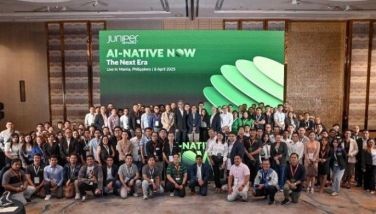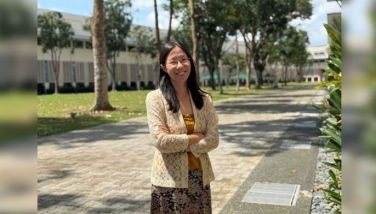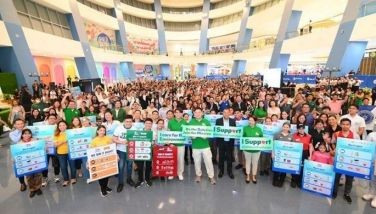Designer with a cause
July 12, 2006 | 12:00am
 Combine a social conscience with a flair for fashion and you get someone like PJ Arañador, a designer with a mission. A discussion with the man often involves references to politics, trends, sustainable growth in the labor industry and, of course, his love for native materials. Dressed in discreetly distressed hip-hugging jeans, a fitted shirt and a wristband, PJ looks more like a rugged concertgoer than what he really is: a designer and businessman with diversified interests. Upon closer inspection of his attire, PJ’s interests come alive. The wristband he’s wearing is made of abaca – natural fibers are a passion of his – and the sandals (or "mandals," as pundits would call them) he’s sporting are from his own store’s production.
Combine a social conscience with a flair for fashion and you get someone like PJ Arañador, a designer with a mission. A discussion with the man often involves references to politics, trends, sustainable growth in the labor industry and, of course, his love for native materials. Dressed in discreetly distressed hip-hugging jeans, a fitted shirt and a wristband, PJ looks more like a rugged concertgoer than what he really is: a designer and businessman with diversified interests. Upon closer inspection of his attire, PJ’s interests come alive. The wristband he’s wearing is made of abaca – natural fibers are a passion of his – and the sandals (or "mandals," as pundits would call them) he’s sporting are from his own store’s production.
Though he’s been in the fashion industry for more than a decade, PJ’s kept a decidedly low profile, which is odd as his resume reads like a publicist’s dream. A charter board member and former VP and secretary general of the Fashion and Design Council of the Philippines (FDCP), he’s participated in trade fairs, both local and abroad, to support struggling designers as a consultant, teaching inexperienced artisans and entrepreneurs the ins and outs of product development and overseas trading.
He cut his teeth working for the Galleon Shop, a hotel-based establishment known for its Asian crafts merchandise. PJ joined the Galleon shortly after dropping out of med school at UP Diliman. Coming from a family of doctors, medicine was in his blood until fashion came calling. Soon, he was creating jewelry for Inno Sotto, which was featured on CNN’s Style with Elsa Klensch.
Inspired by the Butuan gold-digging, his handcrafted jewelry consisted of lata, or hammered tin, with a faux gold finish in filigree. "Some people thought it couldn’t be done," PJ says of transforming such humble material into luxurious pieces. Using a common technique like forging, he was able to morph silvery cuts of tin into elaborate gold accessories. A collaboration with Arturo Luz resulted in jewelry inspired by the artist’s paintings. "One of my buyers later told me that the Queen of Spain wore one of my necklaces."
Not many designers can boast of such blue-blooded clients. Yet PJ – who is the opposite of pretentious – simply shakes off the astounding trivia. Before we could get to the details, he’s back to talking about trade fairs and building a Philippine brand for the international market.
With experience in furniture, fashion and jewelry design, PJ is that triple-threat multi-tasking designer people hear about but never actually see in action. A current design merchandise consultant for 60 major individual exporters and associations here and abroad, his designs have been sold in countries as varied as Japan, South Africa, the US, Germany, Holland, and the Middle East. In between following up production in the province and seeing to his business affairs in Manila, he’s jetting to South America or India to set up another trade fair. To date, he has a studio in Manila for artists and designers to create objets d’art, furniture, and apparel.
"Whenever I talk to foreigners who come to the Philippines, they keep talking about the incredible talent of Filipinos and how we could do so much," he says. "I want people abroad to know who we are and what we can do."
Despite his numerous studying stints at FIT in New York and apprenticeships under the likes of Stefano Poletti (who worked with Thierry Mugler) and Paula Naioni (who currently designs furniture under Casa Armani Home), which he could’ve parlayed into big business, PJ is focusing his efforts on assisting local and regional artists and, in particular, local weavers. "I’ve made it a point to stage fashion shows in my hometown in Iloilo," he says, "because the people who help me produce the collection, from the fabric weavers to the sewers, get to see the end result. One woman, who weaves fabric from her home, cried when she saw the show. It was the first fashion show she’d ever attended."
PJ’s story bears a striking resemblance to that of Kenneth Cole, a designer who used his status in the fashion industry to champion causes like AIDS awareness and human rights. The culturally-savvy Cole utilized his brand’s ad campaigns not only to sell shoes and other wares but to bring issues like urban poverty into the public consciousness through a medium more often associated with superficial matters.
Today, PJ makes it a point to keep natural fibers as an integral part of the products he manufactures, whether it’s a carpet made from abaca, a filmy bolero made of a blend of piña, bamboo and silk (his own creation) or linen pants. The products were made from materials harvested locally and then put together by craftsmen in Iloilo or Boracay (his home base) or Manila. "How does the saying go?" asks PJ. "If the Filipino cannot eat it, he will weave it."
Just as the ‘90s heralded a shift in consumerism abroad, with big business bowing to small companies with a cause (case in point: Starbucks, which made waves with baby boomers who enjoyed purchasing a slightly overpriced cup of java in a container labeled "made with recycled materials" and a message of environmentalism scribbled on the side), the local retail scene is currently experiencing a rush of patriotism (case in point: Bayo’s "Proud to be Pinay" and "I Rock Manila" shirts which were the label’s fastest-selling items). It’s now de rigueur to be proudly Pinoy and it’s this sense of amor patriae that PJ is tapping into.
"The tourists who come to Boracay are always puzzled why the merchandise at our shops is made in China," PJ explains. "They always ask, ‘Don’t you make your own?’ "
It’s a sad fact that most of the products sold here are manufactured abroad, driving labor expenditure out the door instead of in.
"If you open the closet of a Filipino, you’ll find that 80 percent of his clothes are from China," notes PJ.
Earlier last year, PJ set up shop in Boracay, due to the large influx of tourists. "It’s a good way to get your brand out there," he says. "Foreigners can see what we can accomplish and spread the word." Dubbed Nautilus, which focuses on three aspects – well-being, resort and lifestyle – the store has a craft-y, hippie feel. "It’s about going back to basics," he explains, "keeping things natural and giving it a handmade feel."
The merchandise ranges from seaweed soap and even abaca soap to coconut-based massage oil. "You’d be surprised," he says, "with what we can do with abaca." The natural proteins make it ideal not just as a fabric but as a cleanser. His angle is "natural beauty from a natural source."
In keeping with his emphasis on utilizing local materials, the fashions are made out of a variety of fibers – some are commonly used cotton and linen, while others make use of his own blend of piña, silk, and bamboo flax. The interior of the bamboo plant makes it a potentially prolific source for other numerous products, not only furnishings.
"There’s something about the stiffness of woven fibers that provides postura, this starched, sharp silhouette," he says. "Suddenly your back is straighter and you’re walking taller."
Though the materials are stiff, his latest collection is anything but. His menswear consists of patchwork linen and batik fabric, giving it a Zen-like feel. Pants are given a graphic finish with bold splashes of print, reminiscent of Japanese styles, against a subdued palette of neutrals and navy. Shirts are done in a variety of cuts, from loose, resort styles with high collars to khaki, safari-inspired button-downs with military elements. Beach shorts get a makeover with slimmer, tapered silhouettes. No unflattering ballooning effect once you hit the water. Instead, the floral shorts are shaped like the latest pants to hit the Milan runways during fashion week – tighter at the knee for a chicer effect.
His womenswear follows the same theme but the palettes come in softer, more nude hues like bullet gray and tan with samplings of sheer pastels in light coral and peach.
Beach coverups in filmy chiffon are a direct shift from the crocheted fashions peppering seaside escapes, this time hemmed at the bust for a more flattering empire silhouette and given an urban update with kimono and batwing sleeves. It should be noted that PJ’s beachwear easily makes the transition between beachside retreat to club dancefloor. "You can wear it over a black tank top and jeans," he says of one of his sheer coral affairs in chiffon.
There’s an entire arsenal of swimwear that plumbs every designer’s archive of chic beach garb. Bikinis made of cotton knit in flattering white makes any tan – whether it’s still a work in progress or meticulously layered over a week of lounging – look sizzling hot. There are basic styles like the halter and the ubiquitous triangle bikini in go-anywhere shades like terra-cotta and turquoise as well as mod-inspired retro prints and bright florals.
"Design is about simplicity," he explains, "which is the most difficult to do." PJ’s philosophy of simplicity gives his pieces a timeless quality, paring down a piece until all the trappings that could be dubbed dated in a matter of seasons are removed. "I have reason beyond aesthetic," he says. "There are budget constraints and manufacturing issues to take into account."
It’s in the marriage between local materials and cutting-edge technique that the future of Philippine design rests, according to PJ. "Look at Philippine furniture," he says proudly, which has been making its mark at international trade fairs. The sleek styles juxtaposed against textured native fibers are setting trends for contemporary furnishings abroad. "The designs are Bauhaus, but the materials and technology are all our own."
When it comes to design, he says our future is in getting back to basics, revisiting the fibers and textiles that only the Philippines can create. It’s in our traditional weaves, steeped in our culture and that of our neighbors’, coupled with contempo-rary design that makes something Filipino. "That’s what we’re good at," he says, "making beautiful things out of the simplest of materials."
BrandSpace Articles
<
>




















